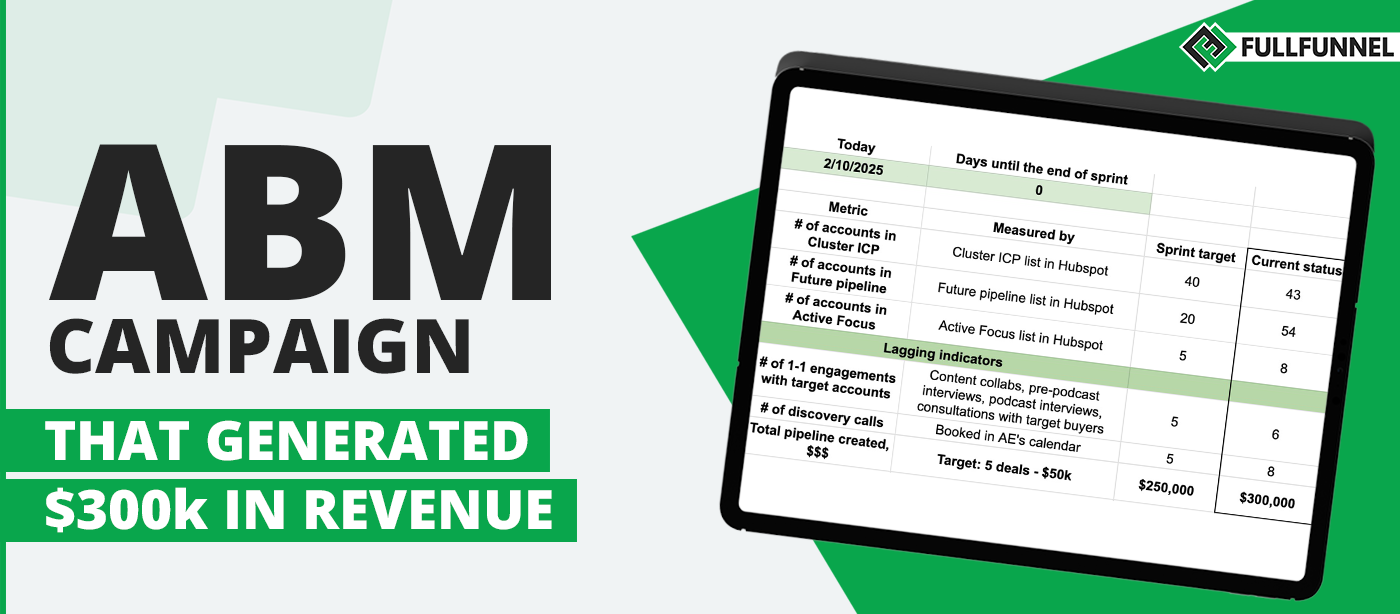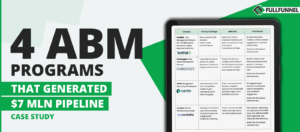In this case study, I share the step-by-step process we used to run an ABM campaign for a high-ticket B2B service provider that generated $300k in revenue and a 37% reply rate (12 of 30 accounts replied).
I spent two months creating a go-to-market strategy and developing lead generation and sales processes for my client from scratch. Next two months, I spent on account research, personalized proposals, warming-up target accounts, and outreach.
While from first glance, it seems that it took too long to orchestrate the campaign, it was even faster than I expected.
Here is why.
I got a request from a new client, a custom software development company, to help them develop a go-to-market strategy and lead generation system. They’ve never done marketing, worked as a “one size fits all” vendor, and grew by referrals and roadshows.
During the discovery call, they mentioned that they do traditional email and LinkedIn outreach, but had a shallow reply rate (less than 2%).
Besides referrals, they attended exhibitions and roadshow booking meetings with event attendees and presenting their services. The only problem was that they saw a massive drop-off after these meetings (5% reply to after-event follow-ups).
Table of Contents
ToggleABM Campaign Stages
Stage 1 – Marketing Audit And Roadmapping
I always start long-term engagement with marketing audit and roadmapping. The goal of the audit is to identify the root reasons for the challenges my client has and other bottlenecks he has no clue about.
Marketing audit helps to:
- Outline all the areas of marketing and sales that need improvement before launching lead generation campaigns.
- Understand what channels and programs will work for the client and eliminate those that won’t work.
- Produce an accurate estimate of the project timeline and cost, preventing irritating and costly overages and delays.
- Define the ROI
During the audit, I’ve figured out that my client doesn’t have an ideal customer profile. They described the target audience as “tech startups who need development help or bigger companies that need to ramp up their team quickly.”
As you guess, thousands of other software development companies all around the world have the same approach. So almost all sales pitches ended with their clients negotiating the rates and comparing them to other vendors. My client either needed to decrease rates or lose the deal.
As a result, I realized we need to develop the go-to-market strategy from scratch.
Stage 2 – ABM Marketing Strategy
While this stage is critical, I won’t dive deeply here. I use a standard framework for B2B marketing strategy development (I’ve described it in the guest post for Sales Hacker).
So I’ll just outline the most critical outcomes.
Market Segmentation
As a result of market segmentation, we have defined that the healthcare segment was more profitable than others. My client had a robust portfolio and domain knowledge. As well, this segment had a higher LTV than others.
Ideal Customer Profile
Geo
US and Canada
Vertical
Healthcare startups
Sub-industries
Software product/SAAS, Hardware/Medical devices, Software consulting, Clinics&Hospitals, Healthcare Insurance.
Our ICP were US and Canada healthcare startups from sub-industries as Software product/SAAS, Hardware/Medical devices, Software consulting, Clinics&Hospitals, Healthcare Insurance.
The only challenge we faced that depending on the client’s maturity, they had different needs, different buying processes and buying committee structure, and, obviously, different revenue potential.
So we needed to create separate ICPs for enterprise, mid-size, and startups. I’ll cover this process later.
Customer journey (typical buying process)
My client never ran in-depth surveys with customers. They had only assumptions about why do their clients buy from them, how their decision-making process looks like and what influences it.
Our next step was to arrange calls with key customers and understand their buying process and identify our value proposition.
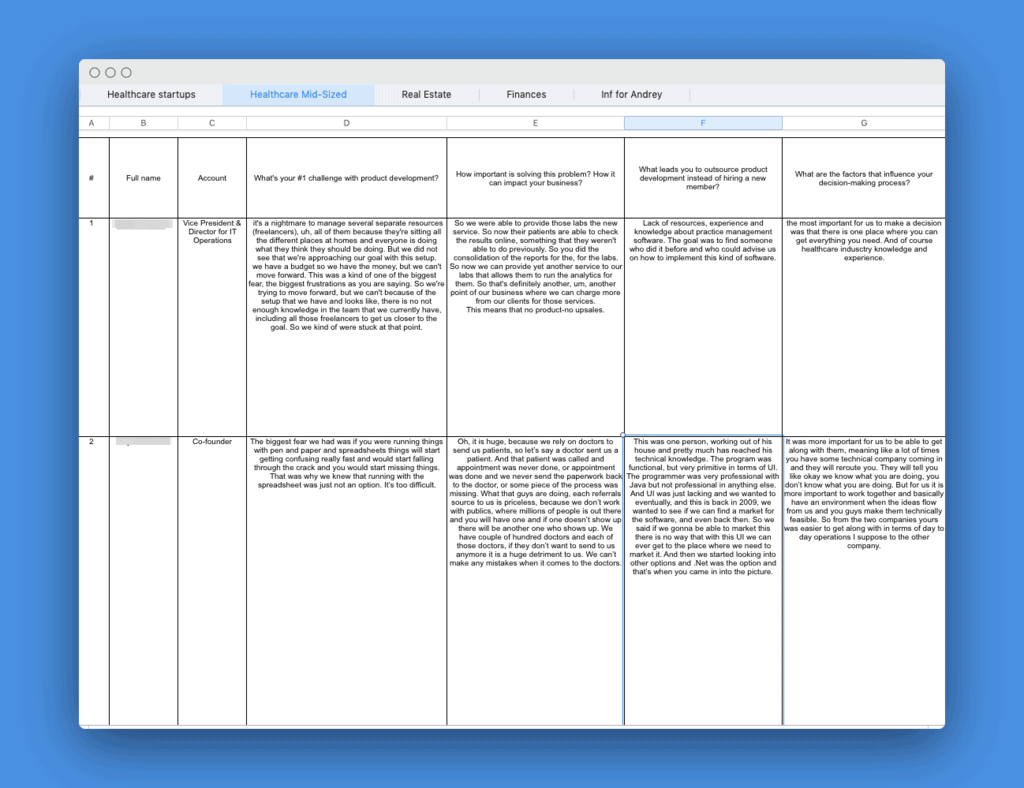
These interviews helped us to identify our unique value proposition and value proposition amplifiers. As well, we became more clear on the buying committee structure and how to influence every buying committee member.
Unique value proposition
Based on client interviews, I made a list of value proposition hypotheses.
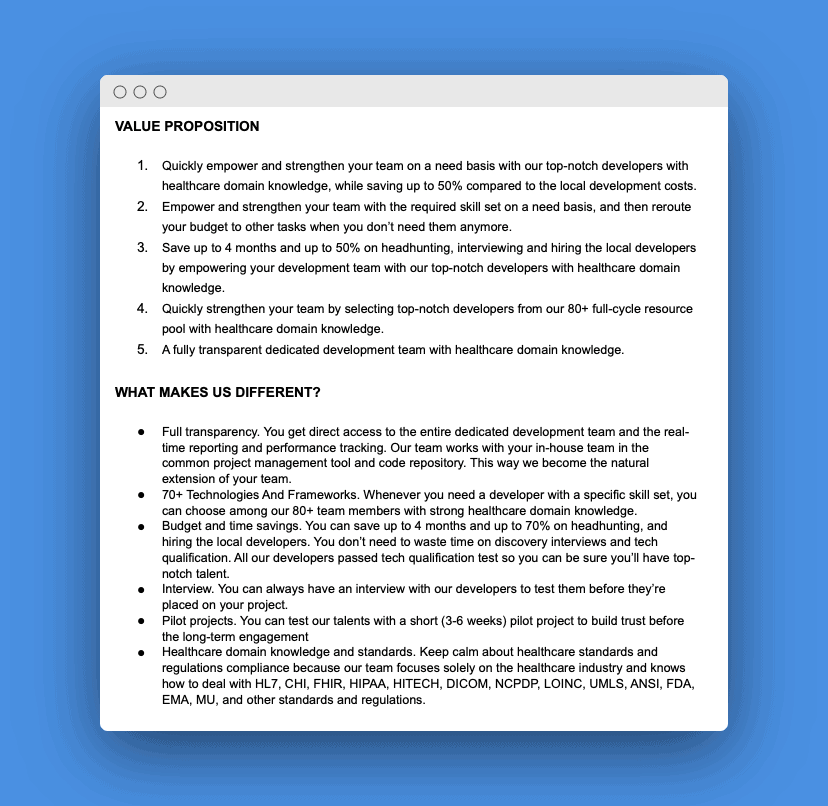
I deliberately called them “hypotheses” cause we needed to validate if they resonate with our clients. So the next step was to run a validation survey.
Here is a part of our survey.
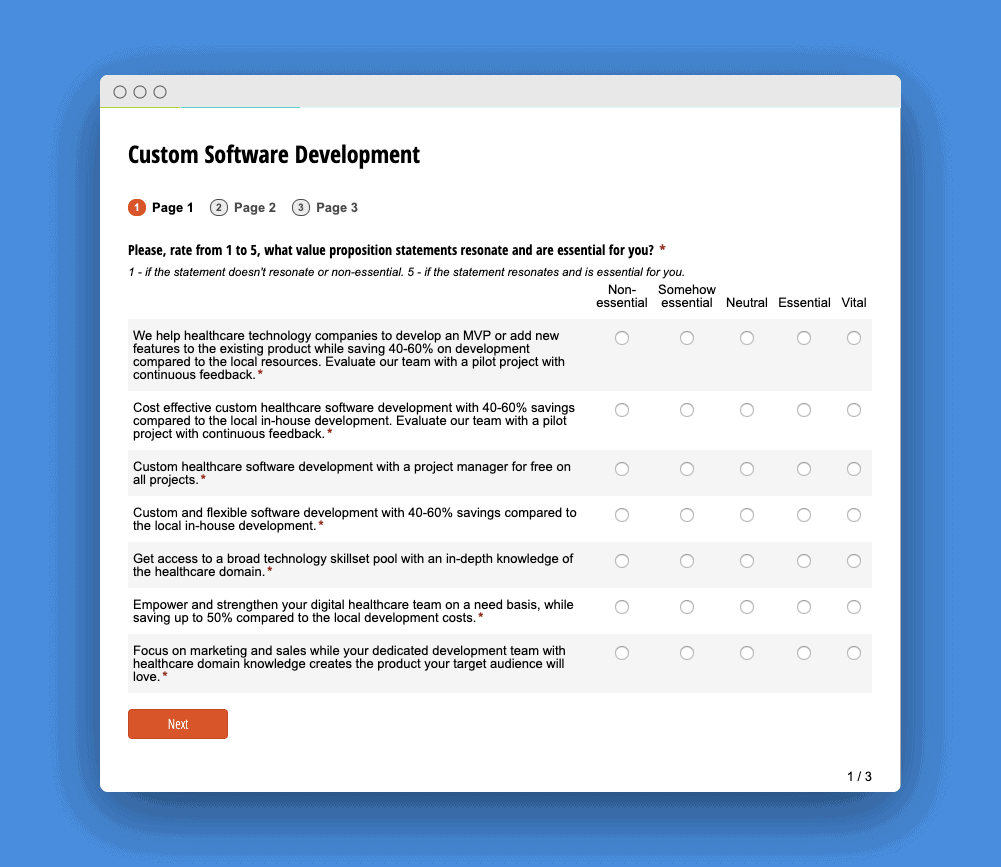
It helped to clarify the hooks and value proposition amplifiers we can use in our outreach.
Account selection and disqualification
The next step was to identify criteria for account selection and disqualification. Unfortunately, I can’t disclose account selection criteria but will provide you disqualification criteria.
The reason why we add them is that we must be clear who is 100% a bad fit so that we won’t waste time and money.
One of the criteria was a country of origin of decision-makers.
CTOs and CEOs from Eastern Europe, India, or Russian-speaking countries usually had a good tech network in their country, and in 99% of cases were negotiating the rates.
The second disqualification criteria were the active hiring of product managers or back-end developers, which means they had root back-end problems and won’t be interested in collaboration at the moment.
Want to launch an effective ABM campaign just in 6 weeks?
We share 4 different campaigns you can launch on a shoestring budget with minimum resources just in 6 weeks in our 6-Weeks ABM playbook.
Stage 3 – Campaign Orchestration
Account categorization and personalization
As I mentioned earlier, we created three tiers of clients.
Tier 3
Team size
Less than 40 people
Buying committee
CTO, product manager, and CEO
Need
Developing specific features according to US medical standards like HL7, HIPAA.
To Tier 3, we added startups with a team size of fewer than 40 people that need help with developing specific features according to US medical standards like HL7, HIPAA.
The buying committee consists of CTO (who is usually a co-founder), product manager (Influencer), and CEO.
We had lots of Tier 3 accounts in CRM. These were prospects with who my client contacted in the past or met on roadshows.
For a pilot campaign, we decided to re-engage 40 accounts with cold email outreach.
Tier 2
Team size
Up to 200 people
Buying committee
Product manager, CTO, senior software engineer, CEO, HR
Need
Quickly ramp up the team with a specific skillset on a timely basis.
Tier 2 – mid-sized companies up to 200 people that need to quickly ramp up the team with a specific skillset on a timely basis.
The buying committee consists of 4 target roles: product manager, CTO, senior software engineer, CEO. As well, I decided to add one more job role, which is usually ignored by software development companies: HR.
The reason why do they ignore HRs is that they tend to think if a company is hiring, then there is no interest in outsourcing/outstaffing services. This is not true, and later, in this case, I’ll prove it.
We selected 30 accounts for the pilot campaign, which consisted of job role personalized pitch via direct mail and phone follow-ups.
Before the campaign has started, my client also asked me to run warming up IP-based ads, which was, honestly, a bad idea. I’ll provide more details on why ads didn’t work in the Execution section.
Tier 1
Tier 1 – enterprise companies (>500 people) that require a 100% personalization.
By 100% personalization, I mean that we adjust and personalize our warm-up and outreach message to every buying committee member and account’s goals and needs.
After a quick discussion, we decided to exclude this segment because of a lack of resources.
Account-based marketing campaign orchestration
The next step was campaign orchestration and alignment with the sales team.
While for Tier 3 account we needed to write a cadence of emails, with Tier 2 accounts we required much more time, as I needed to prepare all the content (case studies, proposals, outreach scripts, landing pages, ads, etc.) from scratch.
Here is how our ABM campaign template and timeline looked like.
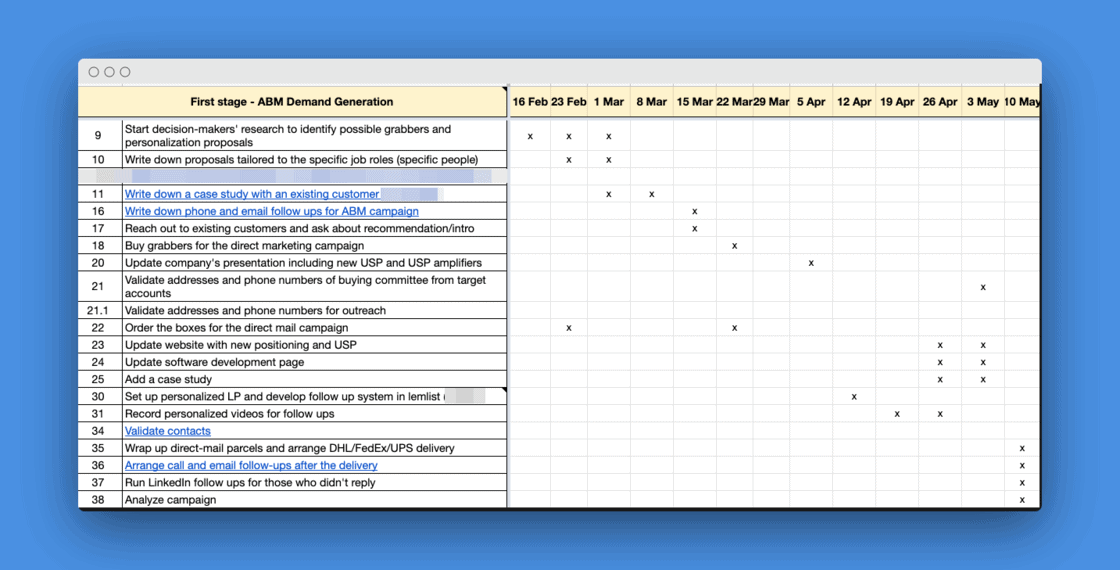
We needed to align the account validation and outreach with the sales team’s schedule cause they were regularly attending industry events.
Stage 4 – ABM Campaign Execution
Account research and validation
As we decided to move with Tiers 3 and 2, we didn’t do in-depth, personalized research as we do with Tier 1. Based on the account research, we figured out four target job roles in the buying committee of Tier 2 accounts: HR, CEO, CTO, and Senior Software Engineer.
Our research goal was to:
- Where these people physically work? Are they working from the same office?
- Are there any scheduled business trips or events so that they will be out of the office?
- What is their internal phone numbers for phone follow-ups
- Make sure nobody from the buying committee had a Ph.D. in post-soviet countries or India
- Make sure they are not actively hiring back-end developers
- Define strategic company’s and product goals from press releases, interviews, conference gigs, or blog posts, so we were sure we are the right fit
- Find their business emails and LinkedIn profiles
With the Tier 3 prospects, we researched only three last points because, as I mentioned above, we decided to run only a cold outreach campaign with LinkedIn follow-ups.
Value propositions for buying committee members
The two most significant mistakes I see companies make at this stage are:
- Ignoring buying committee members and reaching out to decision-makers only
- Reaching out to the buying committee with the same message
What makes sense for the CEO doesn’t usually make sense for software engineers.
While CEOs were looking for ways for development budget optimization and portfolio, software engineers were interested in our tech skillset, capacity, and frameworks we work with.
The same with HRs. They were interested in how quickly we can provide the candidates with a required skill set.
Besides the value proposition, I needed to define the hook based on their challenges and goals. As well as brainstorming the physical gifts (“grabbers”) that can attract their attention, make them smile, and make us sure that we hit the bullseye.
This process was much more straightforward for me because we have done several in-depth interviews with Tier 2 customers, have done account research, and had a good understanding of the challenges and goals of our target job roles.
The value proposition for HRs
I knew that most HRs were in the real challenge of finding local talents with a required skill set, especially when the company needed to ramp up the development team quickly.
As well, from the interviews, I felt that the HR role is underappreciated, so I decided to leverage it in my pitch.
Attention grabber
As an attention grabber, I decided to buy a Superwoman toy that symbolizes how HRs feel themselves. They are always in a rush, doing multiple tasks and balancing between endless headhunting, CV screening, and interviews with candidates.
You might be wondering why did I buy toys? 🙂
Stay tuned, and I’ll describe the reason later in this case study.
I used HRs challenges as a hook to make them smiling and nodding from the first sentence.
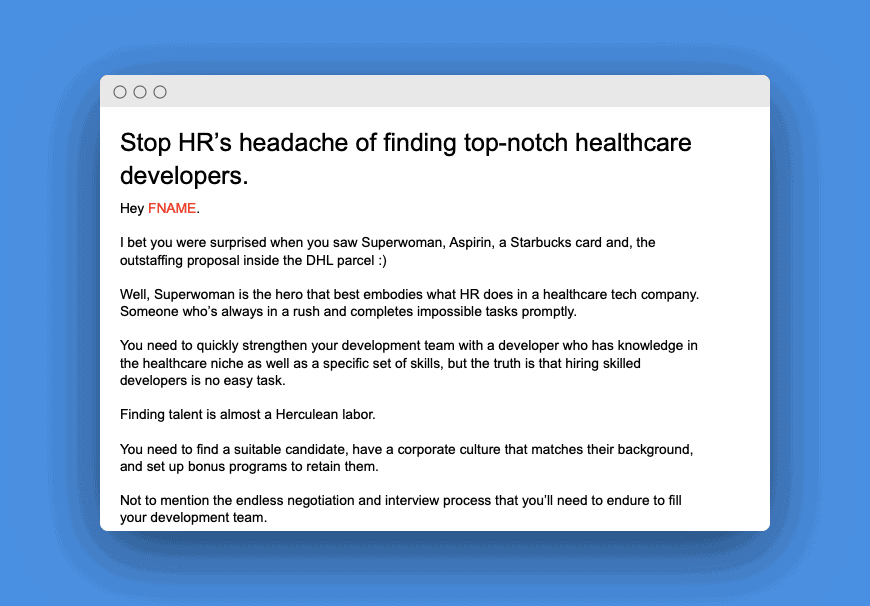
Value proposition
As a business value propositional, I decided to show that we understand the challenge and can quickly ramp up the team with 80 developers. As a personal value proposition, I wanted to show how our service can help HRs to plea the development team needs and boost their credibility and the role of HR in the organization.
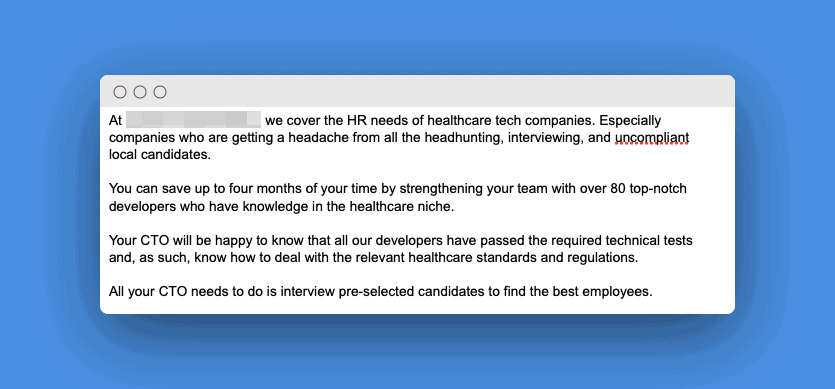
The value proposition for CTOs and Senior Engineers
Attention grabber: Darth Vader toy
The reason why I chose Darth Vader was that the Star Wars movie was trendy among developers, and the new episode of Star Wars was just released. I leveraged the fact that Darth Vader had excellent tech skills but also needed his army: Imperial Stormtroopers to battle the Rebel Alliance.
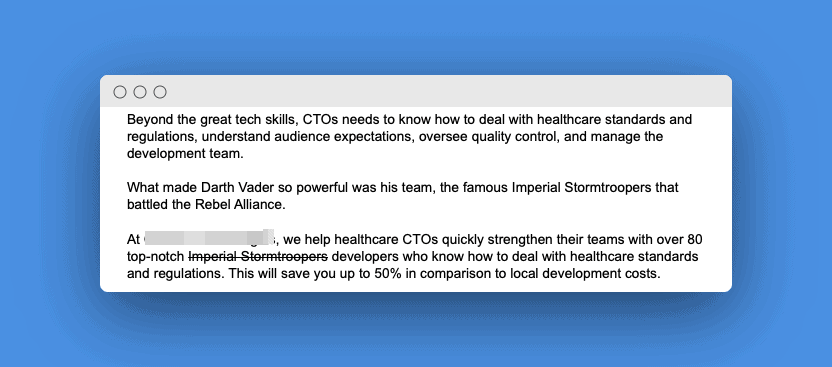
Value proposition
As I mentioned, tech people are interested in our skillset and less in business benefits.
So in the pitch, I mentioned that our team knows how to deal with healthcare standards and regulations. We can fulfill their needs even with a rare skillset (that happened quite often) on a need basis. As well, we are transparent: work in the same code repository, provide real-time reports, and become a natural team extension.
The value proposition for CEOs
Attention grabber: Scrooge McDuck toy
I chose Scrooge deliberately. He was a great CEO that made him one of the wealthiest characters in the Disney world. But here is a funny fact: Scrooge didn’t live in the tech area :).
From interviews, I knew that CEOs feel that they can’t predict the budget and outcome — at least not correctly. They often need to invest in software development without seeing tangible results or improved performance.
That was the biggest pain point.
Value proposition
Besides technical capacity, I focused CEOs’ attention on business benefits that they don’t need to pay for recruiting costs, vacations, sick leaves, office rentals, hardware, or compensation fees when you need to scale down the development department.
Universal grabbers
As universal grabbers, we also bought Aspirin and branded Starbucks gift cards with my client’s logo, value proposition, and email. I used them to remind about challenges funnily and resonate my pitch even more with their needs.
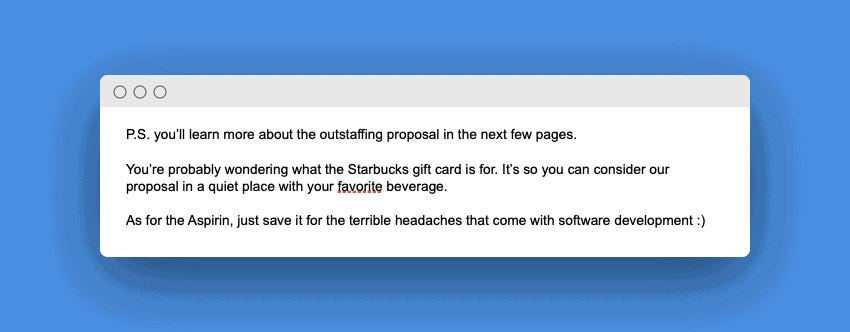
The role of attention grabbers in the direct mail campaign
You might be wondering, why did I decide to buy all this stuff?
I decided to reach out to Tier 2 prospects with direct mail. It’s almost impossible to attract the attention of mid-size or enterprise companies with cold calling or cold emails. Direct mail is something that they don’t expect.
When they receive a parcel from a courier, unpack it and see some unusual gifts that make them curious about the offer. If you chose the right gifts and personalized your pitches, the chances of getting the meeting are very high.
ABM campaign execution for Tier 3
Most software development companies prefer to play the game of numbers and actively spam their prospect via email and LinkedIn.
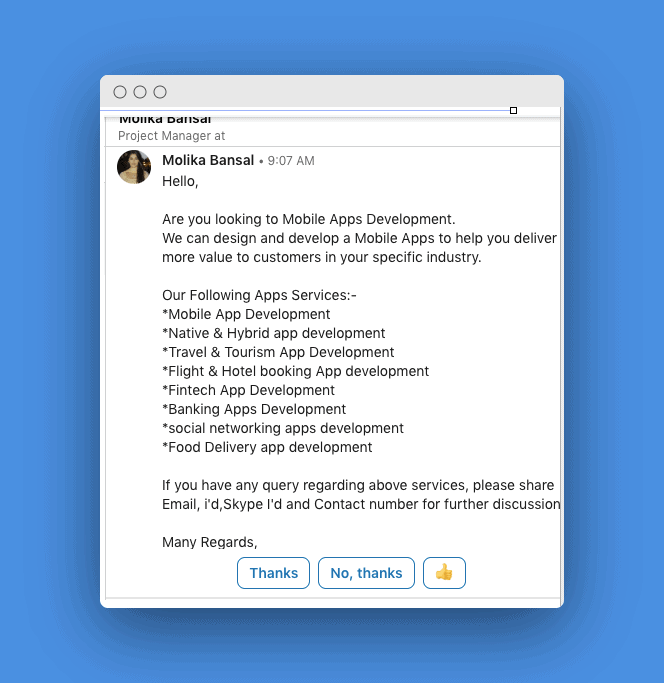
I receive 10-20 pitches every week, and I’m just a little tiny fish in the tech ocean. Guess how many spam pitches get CEOs and CTOs from mid-size and enterprise tech companies?
I hate this “spray and pray” approach.
Even if you do cold outreach, you must be creative and grab attention the same way as with direct mail. So I decided to leverage John Buchan’s method and make my cold outreach funny and creative.
We selected 41 accounts, and I developed a 7-step sequence. The campaign had quite good results:

I won’t dive deeply into the creative part; you can learn more about it here. I want to share the most important details that made this campaign successful.
1. Fun
Most emails sent by BDMs are annoying and immediately go to spam or trash. As I mentioned, our goal is to catch their attention and make them smile.
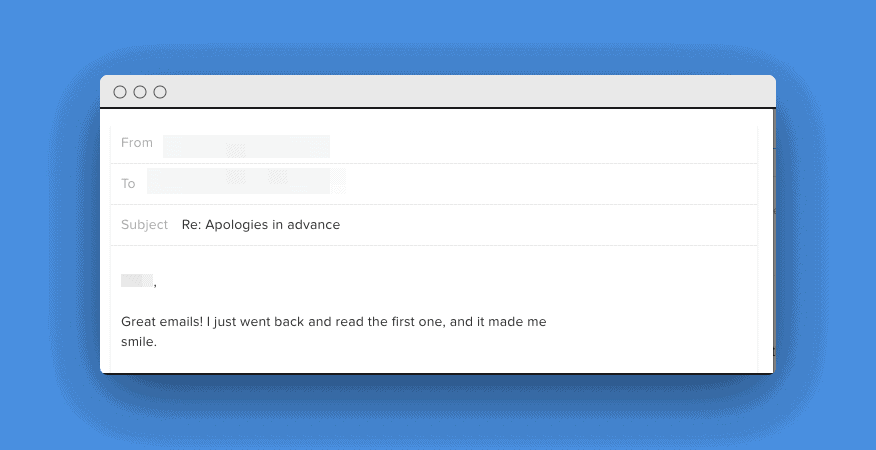
Here is an opener from my first email.
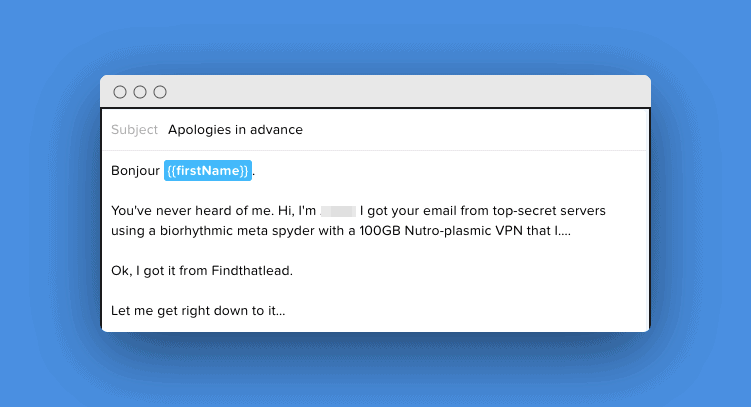
2. Add a business value proposition
Besides fun, you obviously need to demonstrate your unique value proposition. I have described it in the previous step.
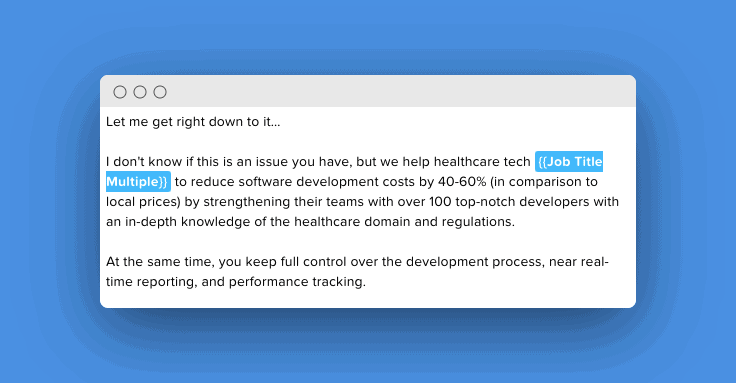
Otherwise, you won’t have positive replies.
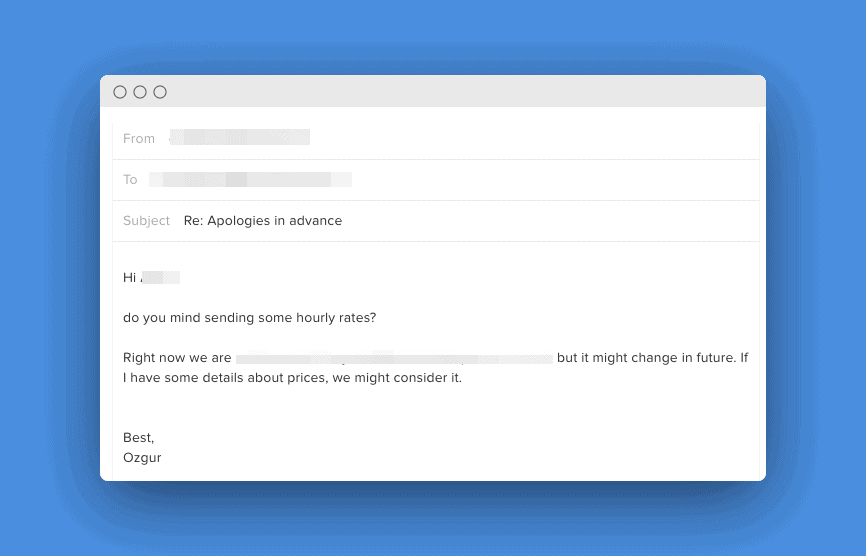
3. Personalized images
Personalized images work. Period.
If you combine a personalized image with creativity, your reply rate will skyrocket. As a result of the campaign, we generated three sales opportunities.
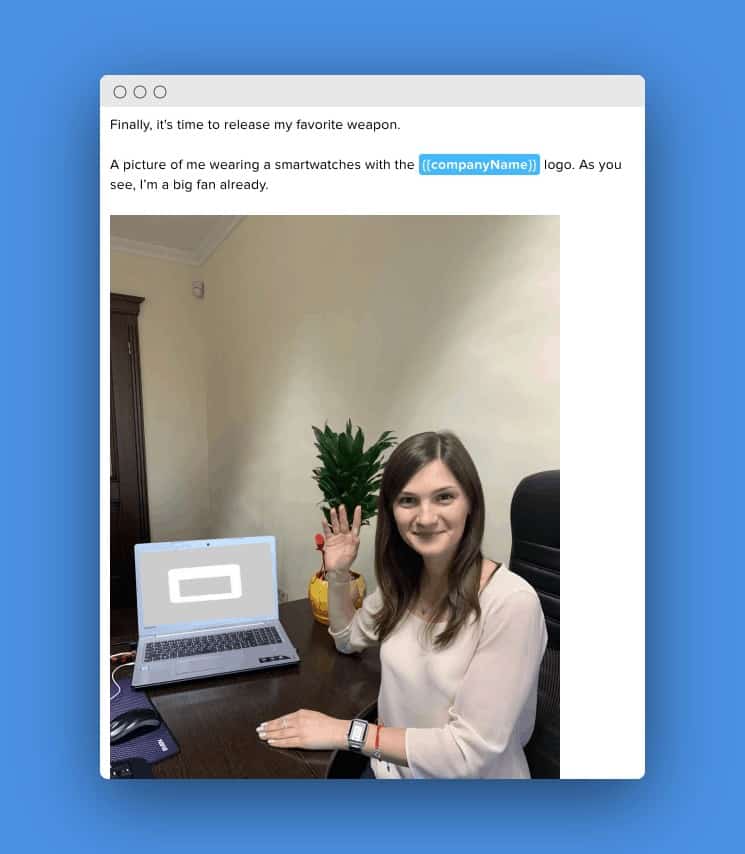
Need help with launching ABM campaigns?
Learn how we can help here.
As well, we share 4 different ABM campaigns you can launch on a shoestring budget with minimum resources just in 6 weeks in our 6-Weeks ABM playbook.
ABM campaign execution for Tier 2
As I mentioned earlier, I decided to reach out to Tier 2 prospects with direct mail.
Our physical parcel included:
- Personalized to job role proposal
- Grabbers
- Detailed service description
- Company’s presentation
- Portfolio
- Niche case study
All documents were printed on a quality, colorful printer to make a positive impression. While we were preparing parcels, I started the warm-up campaign.
Usually, I do a warm-up on LinkedIn (I described the entire process in my LinkedIn B2B content marketing book), but at this time, we didn’t have resources.
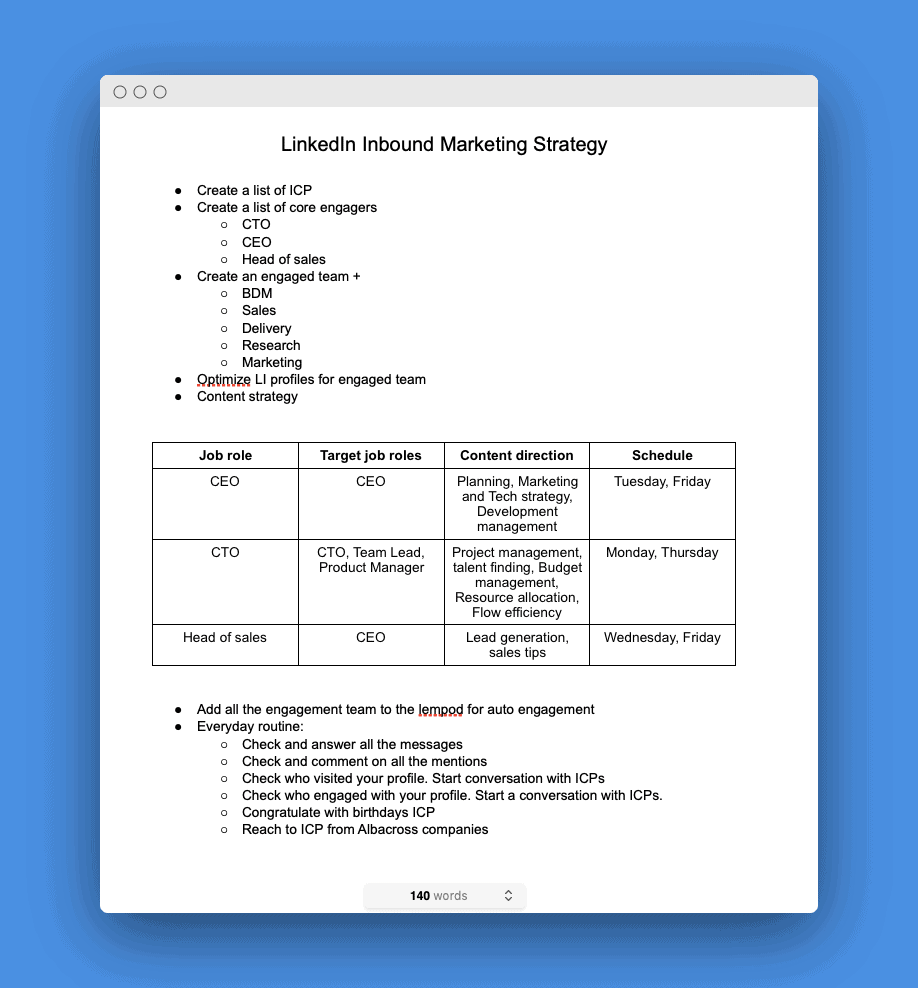
So I ran IP-based banner ads. It didn’t work at all (to be honest, I hate this approach), so I stopped the campaigns after we spent 150 EUR.
When parcels were ready, we reran validation calls to be sure our prospects will be in the office in the upcoming days.
The last step was outreach and follow-ups.
It’s crucial to do direct mail outreach with well-known vendors as DHL or FedEx. Not only they provide you immediate updates about the delivery, but they also generate a sense of importance for the receivers.
When the parcels were delivered, we waited until the next morning for a follow-up.
What is extremely important at this stage is to create a scenario for the sales team on how to overcome the objections. Otherwise, you can miss lots of opportunities.

Prepare all the scripts in advance, discuss them with the sales team, adjust if necessary, and only then start sending the parcels.
Besides the phone follow-up, you need to develop a cadence of touches, cause you won’t reach out 100% of your contacts by phone. Somebody will be busy and can’t talk. In some cases, the secretary or assistant will catch your call. So it makes sense to reach out immediately after the unsuccessful call by email or LinkedIn.
I prefer multichannel touches (email first, the next day – LinkedIn or Twitter).
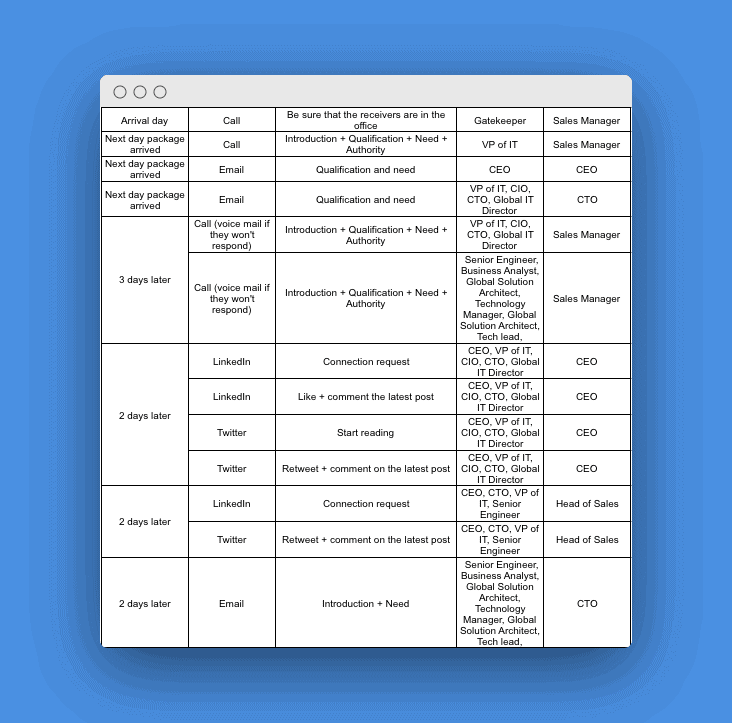
ABM campaign results
This campaign had a 37% reply rate (12 of 30 accounts replied) and a 20% success rate that generated us in total $300 000 in revenue.
What surprised my client (but it wasn’t a surprise for me) is that HRs initiated some sales meetings. Initially, my client was skeptical about prospecting HRs, but this campaign changed their mind.
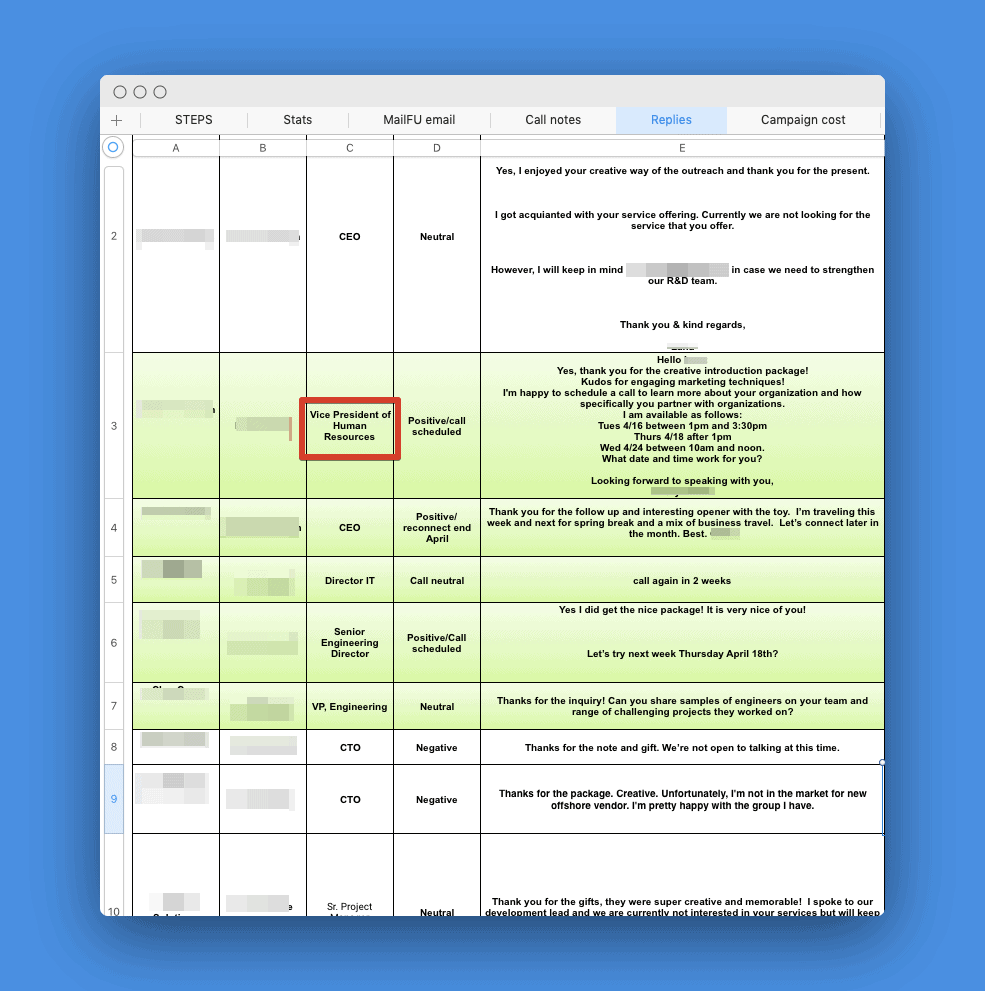
As you might see, we got positive replies from different buying committee members.
Takeaways and further steps
As you see, orchestrating and executing effective ABM campaign takes time and resources but if campaign is done right the ROI might be high. The budget for orchestrating and executing this campaign (of course, without our fee and SDR salaries) was $5k, so the campaign ROI was 6000%. Of course, not every campaign generates same results and not immediately, but this is the only way to grow complex B2B businesses.
If you need help with launching ABM campaigns, book a call here or pm me on LinkedIn. You can learn more about our services here.
If you learned something new from this case study, then you’ll love our 6-Weeks ABM Playbook.
We share our entire account-based marketing process and 4 different ABM campaigns you can launch on a shoestring budget with minimum resources just in 6 weeks

